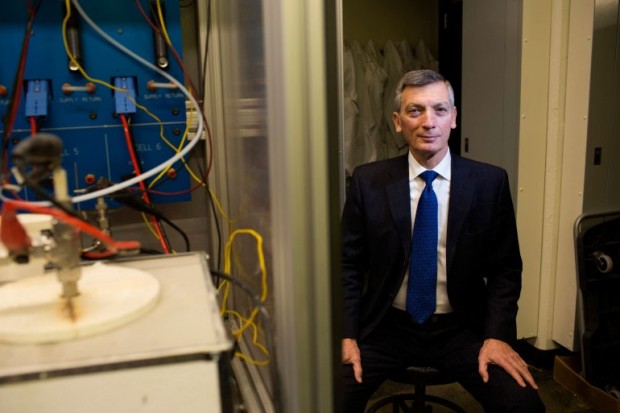توانایی ما در ذخیرهی انرژی به عنوان مشکلی در بکارگیری انرژیهای تجدیدپذیر به شمار میرود. اما اکنون گروهی از پژوهشگران MIT موفق به توسعهی یک سیستم باتری تماما مایع شدهاند که عمر چنین دستگاههایی را افزایش داده، در حالی که هزینهی ساخت کمتری را نیز شامل میشود. بدین ترتیب بنا به اعلام این دانشمندان پیشرفت بدست آمده میتواند انرژیهای بادی و خورشیدی را در رقابت بیشتر با منابع انرژی سنتی قرار دهد.
Donald Sadoway، یکی از استادان شیمی عالی در MIT، مدتیست که مشغول بررسی پتانسیل باتریهای مایع الکتریکی است. این باتریها شامل لایههایی از مواد گداخته هستند که چگالیهای مختلف آن موجب جداسازی طبیعی لایهها میشود، درست مانند جدا شدن روغن از آب.
در این باتری از مینزیم و آنتیموان به عنوان الکترود و از نمک گداخته به عنوان الکترولیت استفاده شده که چنین سیستمهایی به گرمای 700 درجه سانتیگراد (1,292 درجه فارنهایت) جهت اجرا نیاز دارند. اما پژوهشگران دریافتند که با تعویض برخی از مواد و استفاده از آلومینیوم به عنوان یکی از الکترودها و ساختن الکترود دیگر از ترکیبی از سرب و آنتیموان، دمای عملیاتی باتری را میتوانند به میزان 450-500 درجه سانتیگراد (842-932 درجه فارنهایت) کاهش دهند.
از نکات جالبی که توجه پژوهشگران را به خود جلب کرد، مزیت حاصل از ترکیب آنتیموان و سرب در ساخت الکترود بود. آنها ابتدا چنین عقیده داشتند که ولتاژ بالاتر آنتیموان توسط سرب به خطر میافتد و نقطهی ذوب پایینتر سرب با افزودن آنتیموان تهدید میشود. اما پس از آزمایش مشخص شد در حالی که نقطهی ذوب ترکیب حاصل به میزان میانهای رسید، فلز ترکیبی دارای همان ولتاژ بالای آنتیموان است.
دونالد در این مورد گفته است: “ما انتظار داشتیم خصوصیات دو فلز غیرخطی باشند. پس از آزمایش این انتظار ما اثبات شد، اما از سطح تصورات ما فراتر بود. در ولتاژ ترکیب حاصل کاهشی دیده نشد که برای ما نتیجهای خیرهکننده است.”
از آنجایی که نسخهی جدید باتری میتواند در درجه حرارت پایینتر عمل کند، پژوهشگران طراحی آن را سادهتر و عمر آن را بیشتر میدانند و همچنین هزینهی کلی ساخت کمتری را نیز برای آن برشمردهاند. در تستهای انجام شده، مشخص شد که پس از ده سال شارژ و دشارژ روزانه، باتری باید حدود 85 درصد از راندمان اصلی خود را حفظ کند. آنها چنین ادعا میکنند که این راندمان اصلی حدود 70 درصد است، سطح مشابهای با سیستمهای پمپ آبی که نیاز به مقدار آب زیاد و شیبهایی برای اجرای عملیات دارد.
سرپرست این پروژه گفته: “واقعیت این است که ما به کوهستان و همچنین به مقدار زیادی آب نیاز نداریم.”
وی و گروهش به بررسی تاثیر مواد دیگر بر روی سیستم باتری خود میپردازند و امیدوارند بتوانند در هزینههای نهایی و درجه حرارت عملیاتی کاهش بیشتری دهند و عملکرد کلی را ارتقا بخشند.
نتایج پژوهشهای این گروه در ژورنال Nature منتشر شده است.
منبع : gizmag
MIT's improved all-liquid battery could make renewable energy more competitive
MIT's improved all-liquid battery could make renewable energy more competitive
Our ability to store energy has proven a big hurdle in the adoption of renewable energies. But now a team of researchers from MIT has developed a new all-liquid battery system that extends the life of such devices while also costing less to make, a development they say could make wind and solar energy more competitive with traditional sources of power.
Donald Sadoway, a professor of Materials Chemistry at MIT, has been exploring the potential of electrical-grid-scale liquid batteries for some time. These batteries comprise layers of molten material, the varying densities of which cause the layers to separate naturally, much like oil and water.
With magnesium used for one electrode, antimony for another and molten salt serving as the electrolyte, these systems needs to be heated to 700° C (1,292° F) to operate. But the researchers found that exchanging some of the materials, using one electrode made from lithium and another from a combination of lead and antimony, reduces the operating temperature to 450-500° C (842-932° F).
What truly surprised the researchers was the benefits of both the antimony and lead when mixed together to create the electrode. They had anticipated that the higher voltage of the antimony would be compromised by the lead, and the lead’s lower melting point would be compromised by the addition of the antimony. Rather, they found that, while the combined melting point lay in between that of the individual materials, the hybrid metal retained the higher voltage of the antimony.
“We hoped (the characteristics of the two metals) would be nonlinear,” Sadoway says. “They proved to be (nonlinear), but beyond our imagination. There was no decline in the voltage. That was a stunner for us.”
Because the new version of the battery can operate at a lower temperature, the researchers say it will be easier to design and have a longer life, in addition to a lower overall cost. In testing, they found that after 10 years of daily charging and discharging, the battery should maintain about 85 percent of its initial efficiency. They claim this initial efficiency to be around 70 percent, a similar level to pumped-hydro systems which require both large water masses and hillsides to function.
“The fact that we don’t need a mountain, and we don’t need lots of water, could give us a decisive advantage,” says Sadoway.
He and his team will explore the effects of other metals on the battery system and are hopeful of further reducing its cost and operating temperature and improving overall performance.
The team’s research was published in the journal Nature.
 گجت نیوز آخرین اخبار تکنولوژی، علم و خودرو
گجت نیوز آخرین اخبار تکنولوژی، علم و خودرو 







